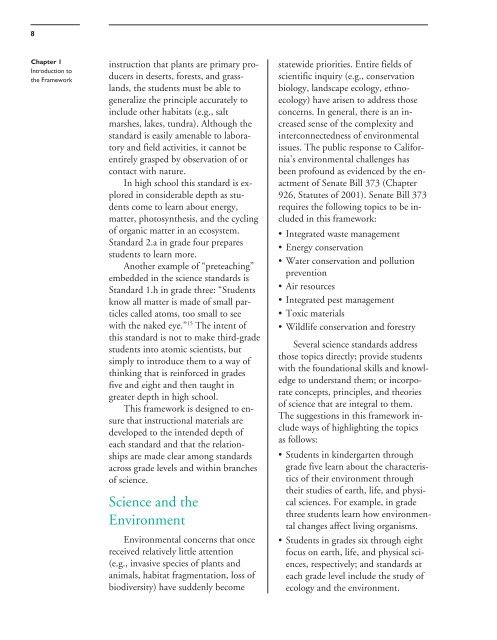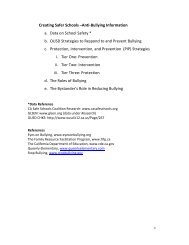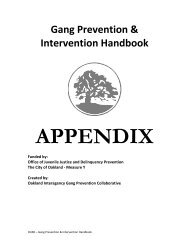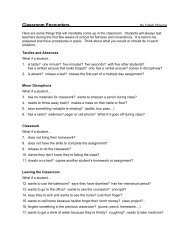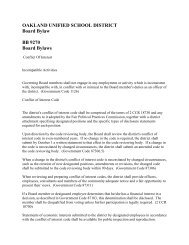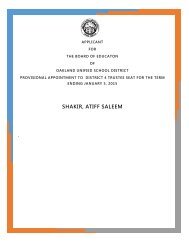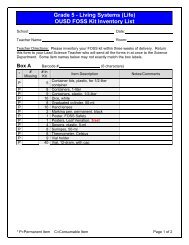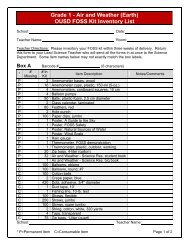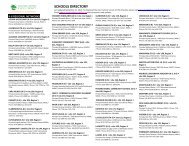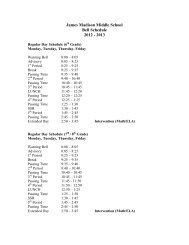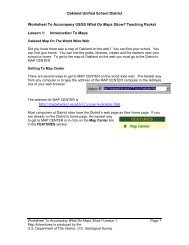Science Framework, part 1 - Free Downloads (CA Dept of Education)
Science Framework, part 1 - Free Downloads (CA Dept of Education)
Science Framework, part 1 - Free Downloads (CA Dept of Education)
- No tags were found...
Create successful ePaper yourself
Turn your PDF publications into a flip-book with our unique Google optimized e-Paper software.
8Chapter 1Introduction tothe <strong>Framework</strong>instruction that plants are primary producersin deserts, forests, and grasslands,the students must be able togeneralize the principle accurately toinclude other habitats (e.g., saltmarshes, lakes, tundra). Although thestandard is easily amenable to laboratoryand field activities, it cannot beentirely grasped by observation <strong>of</strong> orcontact with nature.In high school this standard is exploredin considerable depth as studentscome to learn about energy,matter, photosynthesis, and the cycling<strong>of</strong> organic matter in an ecosystem.Standard 2.a in grade four preparesstudents to learn more.Another example <strong>of</strong> “preteaching”embedded in the science standards isStandard 1.h in grade three: “Studentsknow all matter is made <strong>of</strong> small <strong>part</strong>iclescalled atoms, too small to seewith the naked eye.” 15 The intent <strong>of</strong>this standard is not to make third-gradestudents into atomic scientists, butsimply to introduce them to a way <strong>of</strong>thinking that is reinforced in gradesfive and eight and then taught ingreater depth in high school.This framework is designed to ensurethat instructional materials aredeveloped to the intended depth <strong>of</strong>each standard and that the relationshipsare made clear among standardsacross grade levels and within branches<strong>of</strong> science.<strong>Science</strong> and theEnvironmentEnvironmental concerns that oncereceived relatively little attention(e.g., invasive species <strong>of</strong> plants andanimals, habitat fragmentation, loss <strong>of</strong>biodiversity) have suddenly becomestatewide priorities. Entire fields <strong>of</strong>scientific inquiry (e.g., conservationbiology, landscape ecology, ethnoecology)have arisen to address thoseconcerns. In general, there is an increasedsense <strong>of</strong> the complexity andinterconnectedness <strong>of</strong> environmentalissues. The public response to California’senvironmental challenges hasbeen pr<strong>of</strong>ound as evidenced by the enactment<strong>of</strong> Senate Bill 373 (Chapter926, Statutes <strong>of</strong> 2001). Senate Bill 373requires the following topics to be includedin this framework:• Integrated waste management• Energy conservation•Water conservation and pollutionprevention• Air resources• Integrated pest management• Toxic materials•Wildlife conservation and forestrySeveral science standards addressthose topics directly; provide studentswith the foundational skills and knowledgeto understand them; or incorporateconcepts, principles, and theories<strong>of</strong> science that are integral to them.The suggestions in this framework includeways <strong>of</strong> highlighting the topicsas follows:• Students in kindergarten throughgrade five learn about the characteristics<strong>of</strong> their environment throughtheir studies <strong>of</strong> earth, life, and physicalsciences. For example, in gradethree students learn how environmentalchanges affect living organisms.• Students in grades six through eightfocus on earth, life, and physical sciences,respectively; and standards ateach grade level include the study <strong>of</strong>ecology and the environment.


